4 true differential inputs
Measure differential signals
with a single channel
Choice of accessories for sensitive
low-level, general electronic
& 1kV CAT III applications
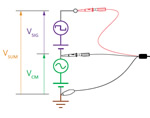
- Flexible 12 or 14-bit resolution, 20 MHz bandwidth
- Up to 400 MS/s sampling rate
- 256 MS capture memory
- High common-mode rejection ratio
- Balanced high-impedance inputs for a low circuit load
- Intelligent probe interface
- Measure non-ground-referenced signal
- Reject common-mode voltages in electronic & biomedical applications
- Safely probe single & 3-phase voltages with 1kV CAT III probes
- Measure power drawn by mobile & IoT devices
The PicoScope 4444: a New Sandard in Differential Measurement
With four true differential inputs, 12 to 14-bit resolution & wide differential & common-mode voltage ranges, the PicoScope 4444 & its accessories offer accurate & detailed measurement for a multitude of applications.
The two key accessories are the new PicoConnect™ differential voltage probes. We have used 9-pin D-type connectors to create a true differential probe interface. These Pico D9 connectors also allow the PicoScope software to automatically identify the probe & select the appropriate display settings.
The TA271 & TA299 adaptors allow you to use the PicoScope 4444 with traditional BNC-connected accessories.
1:1 Differential Probes
With most oscilloscopes, just connecting to the signal of interest can be very frustrating when one of the connection points has to be grounded. With the PicoConnect 441 1:1 differential voltage probe, the PicoScope 4444 high-resolution differential oscilloscope allows the freedom to connect to & visualize signals that are off-limits to a grounded-input oscilloscope. Connect directly to current-sensing resistors & differential signals, or across non-grounded components in a signal path.
The PicoConnect 441 probe does not attenuate your signal & is well suited to numerous electronics applications, as well as biomedical & other scientific research, as it allows high-speed high-resolution measurements on signals between ±10 mV & ±50 V in the presence of commonmode voltages & noise.
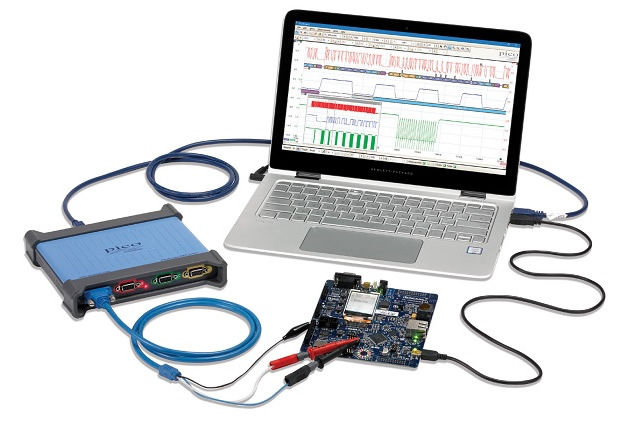
1000 V CAT III Differential Probes
Testing & characterization of power supplies can present the oscilloscope user with many challenges, such as hazardous voltages (often floating without reference to ground), feedback circuitry with electrical isolation, & a wide range of signal levels. One wrong connection of a ground lead & sparks can fly! Using the PicoConnect 442 1000 V CAT III differential voltage probe with the PicoScope 4444, you can easily connect to & visualize the wide range of signals that need to be characterized.
The PicoConnect 442 probe has a 25:1 attenuation ratio & is suitable for testing in a range of applications, including distribution boards, circuit breakers, junction boxes, switches, fixed socket outlets & industrial equipment such as permanently connected stationary motors.
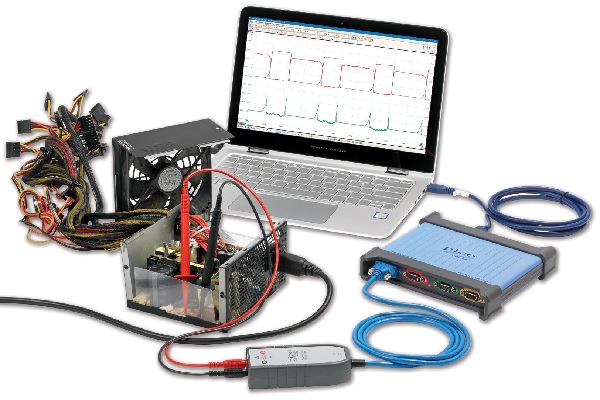
Why Make Differential Measurements?
While you can make a wide variety of measurements with an ordinary ground-referenced scope, there are some circumstances where that just won't work.

Common-mode voltages are unwanted signals that are applied equally to both measurement terminals in your probing system. The circuit above consists of a signal source (purple) with AC and DC components producing a total output of VSIG, which we wish to measure. However, the circuit also contains an unwanted voltage source (green) that also has AC and DC components adding up to VCM, a common-mode voltage. This situation is quite common, for example when probing high-side drivers in amplifiers and power supplies.
As the diagram above shows, probing this circuit with a single-ended scope results in a distorted waveform (VSUM) on the display. We cannot simply connect the probe ground to the negative terminal of VSIG, as that would short-circuit VCM to ground through the oscilloscope, possibly causing a circuit malfunction or damage to the instrument. We need a measuring system that can safely detect VSIG and ignore VCM.
The solution, as shown below, is to connect a differential scope input across the positive and negative terminals of the signal source. The differential input does not measure VCM, only VSIG, so VSIG is what you see on the oscilloscope display.

Differential scopes can measure the AC or DC voltage between two points connected to the positive and negative leads, when neither of the points is grounded. This enables them to take measurements where single-ended scopes can't, for example at voltages that are much higher than ground potential. The resulting measurements focus exclusively on the potential difference between the probes.
Why Use the PicoScope 4444 Differential Oscilloscope?
There are, of course, plenty of differential probes available, all with similar inconveniences: bulky interface boxes, missing or flat batteries, snaking power leads... The PicoScope 4444 uses specially designed passive voltage probes that have smaller and lighter (or no) interface boxes. The PicoScope 4444 has high resolution and deep memory and lets you make multiple differential measurements at the same time, while never occupying more than one power socket. Its intelligent probe interface automatically configures the PicoScope display to your probes, so you don't have to.
True differential measurements in high resolution
The PicoScope 4444's four D9 inputs allow you to make true differential measurements. The maximum input range at full scale is ±50 V (±1000 V using the PicoConnect 442 1000 V CAT III probe), and the maximum common-mode range is also ±50 V (also ±1000 V with the PicoConnect 442 probe). You can set the scope to measure at resolutions of 12 or 14 bits, far better than the 8-bit resolution typical of many oscilloscopes. The deep capture memory (up to 256 million samples shared by the active channels) is another advantage, allowing you to carry out long captures without lowering the sampling rate.
The two images below show a sine wave with a sawtooth interference pattern, displayed on an 8-bit PicoScope 2208B (left) and a PicoScope 4444 in 12-bit mode (right). The PicoScope 2208B has greater bandwidth and a faster sampling rate than the PicoScope 4444, but fails to resolve the fine detail of the signal. The 12-bit resolution of the PicoScope 4444 offers 16 times as much vertical detail, and its deeper capture memory of 256 MS gives it greater horizontal resolution, too.
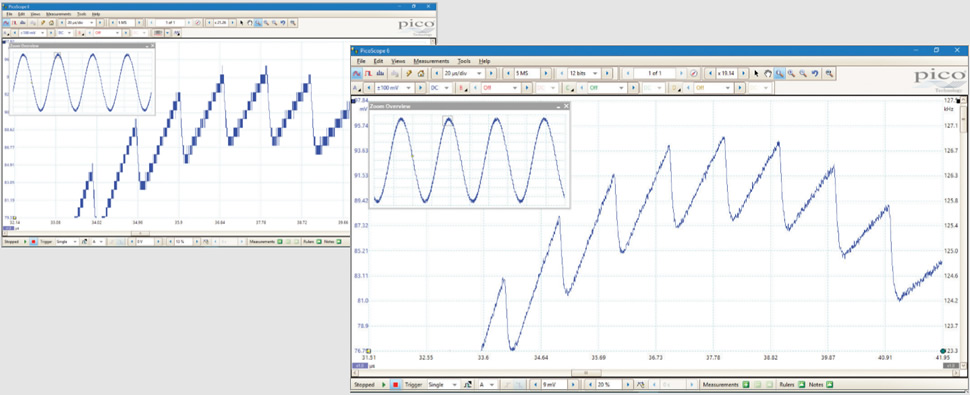
Deep Memory
The PicoScope 4444 oscilloscope offers a large capture memory of 256 MS, allowing it to sustain high sampling rates across long timebases. Running at 12-bit resolution, it can sample at 400 MS/s all the way down to 50 ms/div giving a 500 ms total capture time.
Powerful tools are included to allow you to manage and examine all of this data. As well as functions such as mask limit testing and color persistence mode, the PicoScope 6 software enables you to zoom into your waveform by several million times. The Zoom Overview window allows you to easily control the size and location of the zoom area.
The image below shows how deep memory allows us to zoom in on an individual color burst in an NTSC signal, while preserving the detail of the signal.
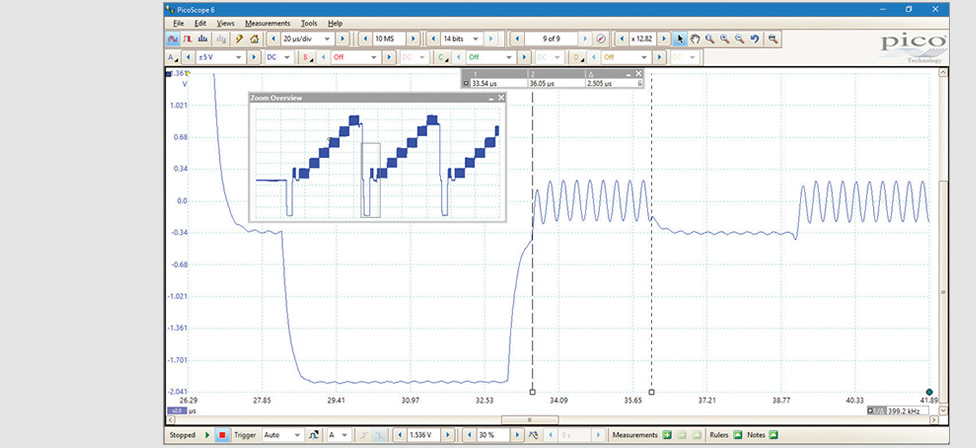

The Buffer Overview window then allows you to rewind and review the history of your waveform.
You can also use it to view mask limit test failures, making it far easier to spot infrequent glitches.
Up to 10 000 waveforms can be stored in the segmented waveform buffer.
When the trace length is set to be shorter than the scope's memory, the PicoScope 4444 will automatically configure the memory as a circular buffer, recording recent waveforms for review. For example, if 1 million samples are captured, up to 250 waveforms will be stored in oscilloscope memory. Tools such as mask limit testing can then be used to scan through each waveform to identify anomalies

Unique Intelligent Probe Interface
When you connect any Pico Technology probe with D9 connection to the PicoScope 4444, the PicoScope 6 software will detect, identify and, where necessary, power it. This means you spend less time setting up and don't have to worry about battery packs or power supplies. The software automatically sets up the display and controls to match your probe.
A notification appears in the bottom right corner of the PicoScope display whenever you connect or remove a probe.
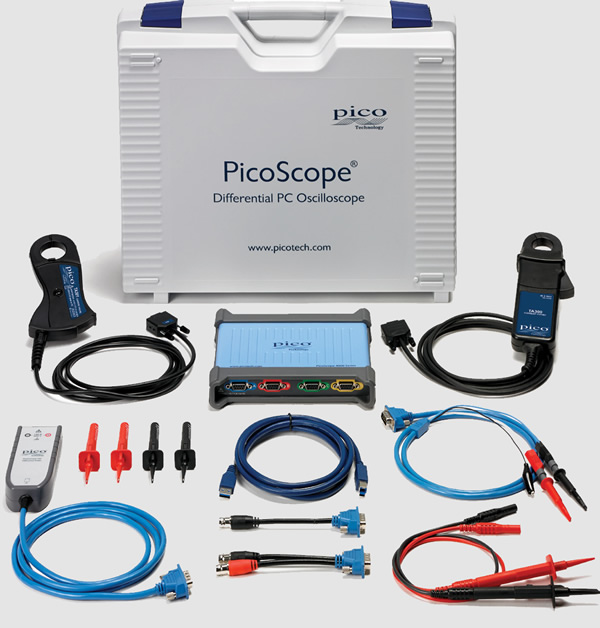
Signal Integrity
Careful front-end design and shielding reduces noise, crosstalk, and harmonic distortion. Years of oscilloscope design experience can be seen in improved bandwidth flatness, low distortion, and excellent pulse response. We are proud of the dynamic performance of our products, and publish their specifications in detail.
The result is simple: when you probe a circuit, you can trust in the waveform you see on the screen.
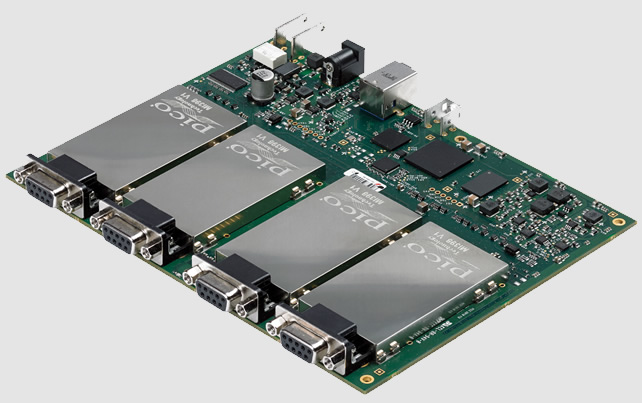
Excellent Value and Convenience
The PicoScope 4444 differential oscilloscopes and their accessories are highly cost-effective, compact and convenient, especially compared to combining a traditional single-ended oscilloscope with the same number of differential probes.
Accessories
The convenient preconfigured kits each include three differential voltage probes with Pico D9 connectors, and a single-ended D9-BNC adaptor. These and a range of other accessories are also available separately. See the table at the bottom of this page for pricing and ordering information.
PicoConnect 441 Probe: measure from millivolts to ±50 V
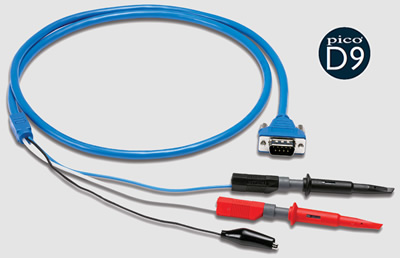
The PicoConnect 441 is a general-purpose passive differential probe with no attenuation and 15 MHz bandwidth, precisely measuring voltages on ranges from ±10 mV to ±50 V. The probe is fitted with a ground reference clip, as well as the usual positive and negative leads, to eliminate unknown common mode voltage differences between the probe and the device under test (DUT). It uses unshrouded 4 mm banana leads, so is compatible with a wide range of test probes: it comes with a pair of sprung hook probes.
This probe is ideal for anyone needing to make lower-amplitude, precision measurements in a wide range of applications. You can also use it to measure the differential outputs of differential serial buses such as CAN or RS-485. Order this probe.
PicoConnect 442 Probe: 1000 V CAT III test leads
The PicoConnect 442 is a passive differential voltage measurement probe with 25:1 attenuation and 10 MHz bandwidth. It is rated for use up to 1000 V CAT III, and using this probe with the PicoScope 4444 is the most cost-effective way to make these measurements safely on multiple channels. With no need for a battery pack, the PicoConnect 442 is suitable for short- and longer-term voltage measurements.
The probe is double-insulated to eliminate the need for a safety ground. It is fitted with shrouded 4 mm banana leads and comes with a selection of suitable test probes.
Applications for this probe include testing the equipment listed for Overvoltage Category III under EN 61010-1:2010, such as measuring voltages on distribution boards, circuit breakers, and fixed socket outlets. Order this probe.
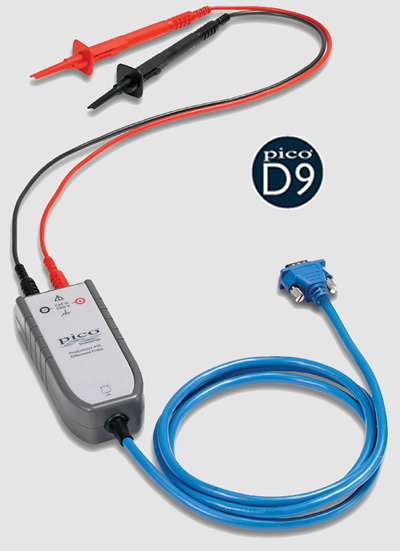
Current Measurement Probes
Two current probes are available with Pico D9 connections. The TA300 and TA301 both use the Hall effect to measure AC and DC currents. The intelligent probe interface means that the probes are powered directly by the PicoScope 4444, so you can use them to measure current for extended periods of time without worrying about flat batteries. It also means that when you connect either of these probes, the PicoScope 6 software automatically configures itself to display your signal.
TA300 Current Probe
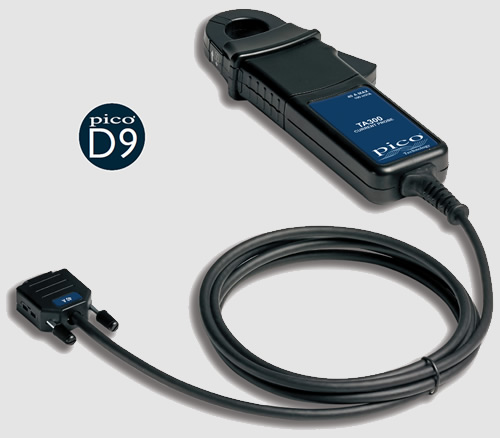
The TA300 current probe is a 40 A AC/DC probe with 100 kHz bandwidth. It is a precision probe for smaller currents, rated for use up to 300 V CAT III on uninsulated conductors.
Overvoltage Category III covers the equipment making up the electrical installation within a building, including distribution boards, circuit breakers, junction boxes, switches, fixed socket outlets and industrial equipment such as permanently connected stationary motors. Order this probe.
TA301 Current Probe
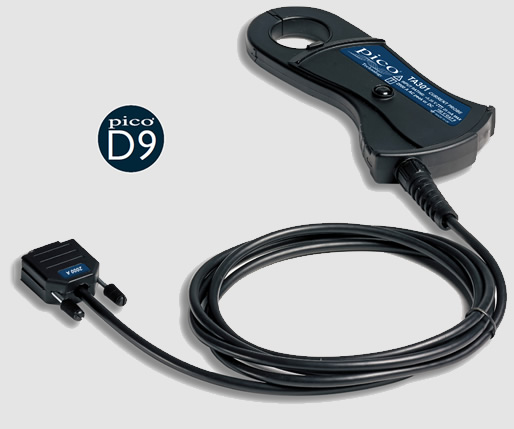
The TA301 current probe is a switched-range 200/2000 A AC/DC probe with 20 kHz bandwidth, rated to 150 V CAT II on uninsulated conductors.
Overvoltage Category II is for equipment powered by wiring within the building, whether it is plugged in at a socket or permanently connected. Order this probe.
Flexible AC Current Probes
The TA325 and TA326 current probes use the Rogowski coil principle to measure AC currents up to 3000 A, without suffering from saturation. These probes have flexible sensor coils, enabling you to measure currents on conductors that clamp-type current probes just can't get to, while the long battery life means you can leave them connected for longer-term measurements.
Both of these probes are fitted with BNC connectors, so you will need to use TA271 single-ended D9-BNC adaptors to connect them to the PicoScope 4444.
TA325 flexible 3-phase current probe *¹
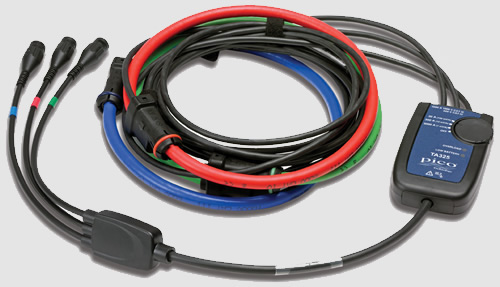
The TA325 is a switched-range 30/300/3000 A AC RMS probe with 10 Hz to 20 kHz bandwidth, rated to 1000 V CAT III on uninsulated conductors. Suitable for measuring 3-phase AC current, it has three sensor coils and scope connection leads, color-coded to match Channels A, B and C in the PicoScope software. Typical battery life is 1000 hours. Order this probe.
*¹Three TA271 D9-BNC adaptors required in order to use this probe with the PicoScope 4444.
TA326 flexible current probe *²
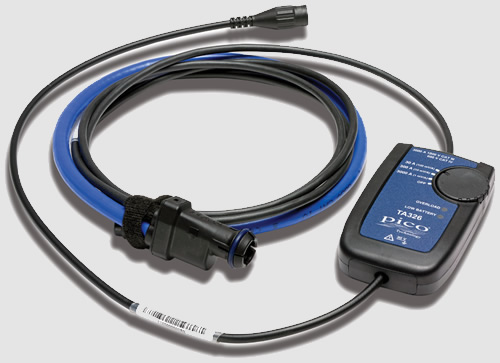
The TA326 is a switched-range 30/300/3000 A AC RMS probe with 10 Hz to 20 kHz bandwidth, rated to 1000 V CAT III on uninsulated conductors. Typical battery life is 2000 hours. Order this probe.
*²One TA271 D9-BNC adaptor required in order to use this probe with the PicoScope 4444.
D9-BNC Adaptors
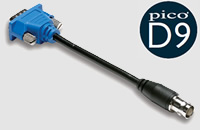
The TA271 D9-BNC adaptor lets you use traditional differential voltage probes and current probes, and make single-ended measurements with a ground-referenced probe. It is also essential when using the TA325 and TA326 current probes.
Order this adaptor.
The TA299 D9-dual BNC adaptor allows you to make differential measurements by connecting two groundreferenced passive probes or cable pairs to one scope input. Order this adaptor.
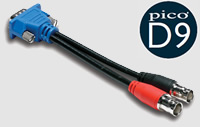
Specifications
| Vertical | ||
|---|---|---|
| OSCILLOSCOPE SPECIFICATIONS | SPECIFICATIONS WITH PICOCONNECT 442 1kV CAT III PROBE | |
| Input channels | 4 channels | One differential pair per connected probe |
| Analog bandwidth (-3 dB) | 20MHz with D9-BNC adaptors 15MHz with PicoConnect 441 probe |
10MHz |
| Rise time (calculated) | 17.5ns with D9-BNC adaptors 23.3ns with PicoConnect 441 probe |
35ns |
| Bandwidth limiter | 100kHz or 1MHz (selectable) | 100kHz or 1MHz (selectable) |
| Vertical resolution, 12-bit mode | 12 bits on most input ranges 11 bits on ±10mV range |
12 bits |
| Vertical resolution, 14-bit mode | 14 bits on most input ranges 13 bits on ±20mV range 12 bits on ±10 mV range |
14 bits |
| Enhanced vertical resolution (PicoScope 6 software), 12-bit mode |
Up to 16 bits on most input ranges Up to 15 bits on ±10 mV range |
Up to 16 bits |
| Enhanced vertical resolution (PicoScope 6 software), 14-bit mode |
Up to 18 bits on most input ranges Up to 17 bits on ±20mV range Up to 16 bits on ±10mV range |
Up to 18 bits |
| Input type | Differential 9-pin D-subminiature, female |
Differential 2 x 4 mm sockets, shrouded |
| Input characteristics |
1 MΩ ±1%, in parallel with 17.5pF ±1pF (each differential input to scope ground). <1pF difference between ranges. |
16.7MΩ ±1%, in parallel with 9.3pF ±1pF (each differential input to scope ground) |
| Input coupling | AC or DC (selectable) | AC or DC (selectable) |
| Input sensitivity | 2mV/div to 10V/div | ±0.5V/div to ±200V/div |
| Input ranges (full scale) | ±10mV, ±20mV, ±50mV, ±100mV, ±200mV, ±500mV, ±1V, ±2V, ±5V, ±10V, ±20V, ±50V |
±2.5V, ±5V, ±12.5V, ±25V, ±50V, ±125V, ±250V, ±500V, ±1000V |
| Input common mode range | 5V on ±10mV to ±500mV ranges 50V on ±1V to ±50V ranges |
125V on ±2.5V to ±12.5V ranges 1000V on ±25V to ±1000V ranges |
| DC accuracy (DC to 10 kHz) | ±1% of full scale, ±500µV | ±3% of full scale, ±12.5mV |
| Analog offset range | ±250mV on ±10mV to ±500mV ranges ±2.5V on ±1V to ±5V ranges ±25V on ±10V to ±50V ranges |
±6.25V on ±2.5V to ±12.5V ranges ±62.5V on ±25V to ±125V ranges ±625V on ±250V to ±1000V ranges |
| Analog offset accuracy | 1% of offset setting in addition to basic DC accuracy | 1% of offset setting in addition to basic DC accuracy |
| Overvoltage protection |
±100V DC + AC peak (any differential input to ground) ±100 DC + AC peak (between differential inputs) |
1000V CAT III (any differential input to ground) 1000V CAT III (between differential inputs) |
| Horizontal | ||
|---|---|---|
| Maximum sampling rate (real time)12-bit mode | 1 channel: 400MS/s 2 channels: 200MS/s 3 or 4 channels: 100MS/s |
|
| Maximum sampling rate (real time) 14-bit mode |
1 channel: 50MS/s 2 channels: 50MS/s 3 or 4 channels: 50MS/s |
|
| Maximum sampling rate (USB streaming) | 10MS/s | |
| Capture memory (real time) | 256MS shared between active channels | |
| Capture memory (USB streaming) | 100MS (shared between active channels) | |
| Maximum duration of capture at fastest sampling rate (real time), 12-bit mode | 500ms | |
| Maximum duration of capture at fastest sampling rate (real time), 14-bit mode | 5s | |
| Maximum waveform buffer segments | 10 000 | |
| Fastest real-time collection time, 12-bit mode | 50ns (5ns/div) | |
| Fastest real-time collection time, 14-bit mode | 200ns (20ns/div) | |
| Slowest real-time collection time | 50 000s (5000s/div) | |
| Collection time accuracy | ±50ppm (5ppm/year aging) | |
| Sample jitter | 3ps RMS typical | |
| ADC sampling | Simultaneous sampling on all enabled channels | |
| Dynamic Performance (Typical) | ||
|---|---|---|
| OSCILLOSCOPE SPECIFICATIONS | SPECIFICATIONS WITH PICOCONNECT 442 1kV CAT III PROBE | |
| Crosstalk | 2000:1 DC to 20MHz | 2000:1 DC to 10MHz |
| Harmonic distortion at 100kHz, 90% of full scale | < -70dB on ±50mV ranges and higher < -60dB on ±10mV and ±20mV ranges |
< -70dB |
| SFDR | > 70dB | > 70dB |
| ADC ENOB, 12-bit mode | 10.8 bits | 10.8 bits |
| ADC ENOB, 14-bit mode | 11.8 bits | 11.8 bits |
| Noise | < 180µV RMS on ±10mV range | < 5mV RMS on ±2.5V range |
| Bandwidth flatness | (+0.1dB, -3 dB) DC to full bandwidth | (+0.1dB, -3 dB) DC to full bandwidth |
| Common mode rejection ratio | 60dB typical, DC to 1MHz | 55dB typical, DC to 1MHz |
| Triggering | ||
|---|---|---|
| Source | Any channel | |
| Trigger modes | None, auto, repeat, single, rapid | |
| Trigger types | Edge, window, pulse width, window pulse width, dropout, window dropout, interval, runt pulse, logic | |
| Trigger sensitivity | Digital triggering provides up to 1 LSB accuracy up to full bandwidth | |
| Maximum pre-trigger capture | 100% capture length | |
| Maximum trigger time-delay | 4 billion samples | |
| Trigger rearm time | < 2µs on fastest timebase | |
| Maximum trigger rate | 10 000 waveforms in a 12ms burst | |
| Probe Compensation Pins | ||
|---|---|---|
| Output level | 4V peak | |
| Output impedance | 610Ω | |
| Output waveforms | Square wave | |
| Output frequency | 1kHz | |
| Overvoltage protection | ±10V | |
| Math Channels | ||
|---|---|---|
| Functions | -x, x+y, x-y, x*y, x/y, x^y, sqrt, exp, ln, log, abs, norm, sign, sin, cos, tan, arcsin, arccos, arctan, sinh, cosh, tanh, freq, derivative, integral, min, max, average, peak, delay, duty, highpass, lowpass, bandpass, bandstop | |
| Operands | A, B, C, D, T (time), reference waveforms, constants, pi | |
| Automatic Measurements | ||
|---|---|---|
| Scope mode | AC RMS, true RMS, frequency, cycle time, duty cycle, DC average, edge count, falling edge count, rising edge count, falling rate, rising rate, low pulse width, high pulse width, fall time, rise time, minimum, maximum, peak to peak | |
| Spectrum mode | Frequency at peak, amplitude at peak, average amplitude at peak, total power, THD %, THD dB, THD+N, SFDR, SINAD, SNR, IMD | |
| Statistics | Minimum, maximum, average and standard deviation | |
| Serial Decoding | ||
|---|---|---|
| Protocols | 1-Wire, ARINC 429, CAN, CAN FD, DCC, DMX512, Ethernet 10Base-T, FlexRay, I²C, I²S, LIN, PS/2, SENT, SPI, UART (RS-232 / RS-422 / RS-485), USB 1.0/1.1 | |
| Mask Limit Testing | ||
|---|---|---|
| Statistics | Pass/fail, failure count, total count | |
| SDK/API Details & Specifications for Users Writing their own Software (see “Horizontal” above for details when using PicoScope 6 software) | ||
|---|---|---|
| Supplied drivers | 32 and 64-bit drivers for Windows 7, 8 and 10 Linux drivers Mac OS X drivers |
|
| Example code | C, C#, Excel VBA, VB.NET, LabVIEW, MATLAB | |
| Maximum sampling rate (USB streaming) | 50MS/s | |
| Capture memory (USB streaming) | Up to available PC memory | |
| Segmented memory buffers | > 1 million | |
| General Specifications | ||
|---|---|---|
| Connectivity | USB 3.0, USB 2.0 | |
| Device connector type | USB 3.0, Type B | |
| Power requirements | USB port or external DC PSU, depending on connected accessories | |
| Dimensions | 190 x 170 x 40mm including connectors | |
| Weight | < 0.5kg | |
| Temperature range, operating | 0°C to 45°C | |
| Temperature range, operating, for quoted accuracy | 15°C to 30°C | |
| Temperature range, storage | -20°C to 60°C | |
| Humidity range, operating | 5% to 80% RH non-condensing | |
| Humidity range, storage | 5% to 95% RH non-condensing | |
| Altitude | Up to 2000 m | |
| Pollution degree | Pollution degree 2 | |
| Safety approvals | Designed to EN 61010-1:2010 | |
| EMC approvals | Tested to EN 61326-1:2013 and FCC Part 15 Subpart B | |
| Environmental approvals | RoHS and WEEE compliant | |
| Software | PicoScope 6, Linux drivers, Windows SDK and example programs | |
| PC requirements | Windows 7, 8 or 10, 32-bit or 64-bit. Hardware requirements as operating system. |
|
Pricing
Oscilloscope kits
| Order code | Product name | Description | Price |
|---|---|---|---|
| PQ073 | PicoScope 4444 standard kit | High-resolution differential oscilloscope with three PicoConnect 441 1:1 passive differential voltage probes and one TA271 single-ended D9-BNC adaptor | NZ$3245.00*Order |
| PQ074 | PicoScope 4444 1kV CAT III kit | High-resolution differential oscilloscope with three PicoConnect 442 1000V CAT III passive differential voltage probes and one TA271 single-ended D9-BNC adaptor | NZ$4065.00*Order |
| PQ088 | PicoScope 4444 oscilloscope | High-resolution differential oscilloscope. Not available separately: must be purchased with at least one of the Pico D9 accessories listed below. | NZ$2690.00*Order |
Accessories
| Order code | Product name | Description | Connector | Price |
|---|---|---|---|---|
| PQ098 | PicoConnect 441 probe | Passive differential 1:1 15MHz voltage measurement probe. Supplied with detachable black and red sprung hook probe tips. | Pico D9 | NZ$92.00* Order |
| PQ087 | PicoConnect 442 probe | 1000V CAT III, passive differential 25:1 10MHz voltage measurement probe. Supplied with detachable shrouded black and red sprung hook probe tips. | Pico D9 | NZ$374.00* Order |
| TA300 | TA300 AC/DC current probe | 40A AC/DC, 300V CAT III, 100kHz current measurement probe | Pico D9 | NZ$674.00*Order |
| TA301 | TA301 AC/DC current probe | 200/2000A AC/DC, 150V CAT II, 20kHz current measurement probe | Pico D9 | NZ$408.00*Order |
| TA325 | TA325 flex current probe 3-phase | Flexible 3-phase switched-range 30/300/3000 A AC RMS, 1000V CAT III, 10Hz to 20kHz current probe. Requires 3x TA271 D9-BNC adaptor (sold separately). | 3x BNC | NZ$1470.00*Order |
| TA326 | TA326 flex current probe | Flexible single-phase switched-range 30/300/3000A AC RMS, 1000V CAT III, 10Hz to 20kHz current probe. Requires 1x TA271 D9-BNC adaptor (sold separately). | BNC | NZ$698.00*Order |
| TA271 | TA271 D9-BNC adaptor | D9-BNC adaptor suitable for ground-referenced measurements using a single voltage or current probe with BNC connector | Pico D9 | NZ$39.00*Order |
| TA299 | TA299 D9-dual BNC adaptor | D9-dual BNC adaptor suitable for differential measurements using two single-ended probes with BNC connectors | Pico D9 | NZ$56.00*Order |
| PA149 | Carry case | Portable carry case to hold the PicoConnect 4444 and its accessories | N/A | NZ$239.00*Order |
